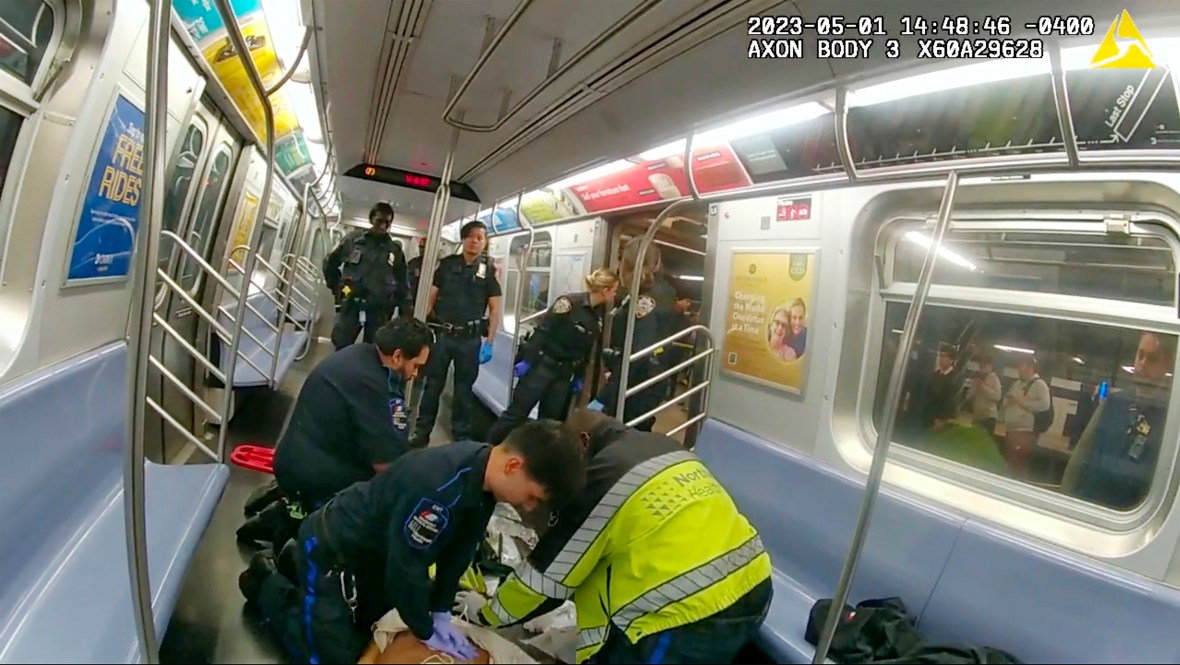Former Marine misused a combat technique in fatal subway chokehold of Jordan Neely, trainer testifies

Prosecutors allege that Penny “went way too far” in his attempt to restrain Neely, showing an “indifference” toward his life even after he had lost consciousness and stopped fighting back.
When Daniel Penny wrapped his arm around the neck of a homeless man on a Manhattan subway last year, the 25-year-old veteran appeared to be deploying a non-lethal chokehold long drilled into U.S. Marines.
Done right, the maneuver should knock a person out without killing them, according to Joseph Caballer, a combat instructor in the Marine Corps who trained Penny in several types of holds. But held too long, the technique can restrict the flow of blood to a person’s brain, ending their life in a matter of minutes.
“Once the person is rendered unconscious, that’s when you’re supposed to let go,” Caballer told a jury on Thursday.
His testimony came weeks into the trial of Penny, who faces charges of manslaughter and criminally negligent homicide after placing Jordan Neely, a homeless man and Michael Jackson impersonator, in the fatal chokehold last May.
Prosecutors allege that Penny “went way too far” in his attempt to restrain Neely, showing an “indifference” toward his life even after he had lost consciousness and stopped fighting back.
Penny, an architecture student who served four years in the U.S. Marines, told police he was seeking to protect himself and other riders from a man who was acting erratically on the train and frightening riders with distressing comments. His attorneys have emphasized Neely’s previous arrests, along with his struggles with mental illness and drug use.

Bystander video of the encounter shows Penny with his bicep pressed across Neely’s neck and his other arm on top of his head, a position he held for close to six minutes, even after the man went limp.
The technique — an apparent “blood choke” — can make a person feel like “trying to breathe through a crushed straw,” Caballer said. In his own training sessions, Caballer recalled telling his fellow Marines: “You don’t want to keep holding on. This can result in actual injury or death.”
Asked by prosecutors whether Penny has used the chokehold in an “improper” manner, Caballer said that he had.
Attorneys for Penny argue their client had sought to restrain Neely by placing him in a headlock, but that he did not apply strong force throughout the interaction. They have raised doubt about the city medical examiner’s finding that Neely died from the chokehold, pointing to his health problems and drug use as possible factors.
Pressed by Penny’s attorney, Caballer acknowledged that he could not “definitively tell from watching the video how much pressure is actually being applied.” But at times, he said, it appeared that Penny was using a hold that may have cut off the flow of blood to Neely’s brain.
“He could possibly be cutting off maybe one of the carotid arteries,” the witness added.
Later in the afternoon, Dr. Cynthia Harris, the city medical examiner who inspected Neely’s body, reiterated her finding that he had died from a lack of oxygen caused by the chokehold. Though she did not describe the exact process of asphyxiation, she testified that “blocking both arteries in both veins, could kill a person in a matter of seconds.”
Jurors were also shown video for the first time Thursday of Penny demonstrating the chokehold to detectives during an interview inside the precinct.
“He had his back turned to me and I got him in a hold, got him to the ground, and he’s still squirming around and going crazy,” Penny said, adding: “He gets a burst of energy at one point and I did have to hold him a little more steady.”
Harris is expected to be the final witnesses called by prosecutors in a trial that has divided New Yorkers and cast a national spotlight on the city’s response to crime and disorder in its transit system. It’s unclear whether Penny will take the stand.
In the eighteen months since the killing, Penny has been embraced by conservatives as a good Samaritan who used his military training to protect his fellow riders. U.S. Rep. U.S. Matt Gaetz, who President-elect Donald Trump nominated this week as his attorney general, described him as a “Subway Superman.”
But the trial has also drawn near daily protests from Black Lives Matter activists, who’ve labeled Penny a racist vigilante who overreacted to a Black man in the throes of a mental health episode.
Penny faces up to 15 years in prison if he is convicted.
More must-reads:

